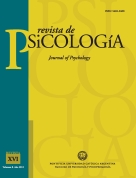Evaluación perceptivo auditiva de voces degradadas y su correlación con medidas acústicas
Palabras clave:
Desórdenes vocales, Análisis acústico de voz, GRBAS, Análisis perceptual de la vozResumen
El objetivo es determinar utilizando las mediciones acústicas, qué información es más relevante para el oyente al momento de categorizar el grado general de disfonía. Se eligieron 8 (4 voces femeninas y 4 voces masculinas. Cada emisión fue evaluada auditivo perceptualmente a través del item G de la escala GRBAS por 10 oyentes experimentados y acústicamente mediante medidas de aperiodicidad, ruido y caos. El estudio estadístico de análisis discriminante señala la importancia de GNE, Jit y Jitter_cc y Lyapunov como parámetros predictores del grado general de disfonía.
La aplicación del método k-means evidencia que existen rasgos en los parámetros acústicos empleados que permiten agrupar objetivamente las voces estudiadas con 100% de precisión para la clase 0, 96% a la clase 2 y 79% a la clase 3. Un mayor número y variabilidad de casos se necesita a fin de verificar los resultados preliminares.
Descargas
Descargas
Publicado
Cómo citar
Número
Sección
Licencia
















